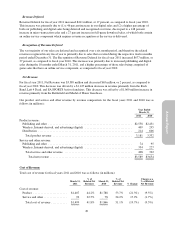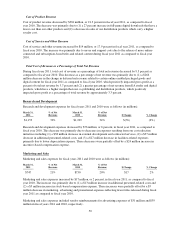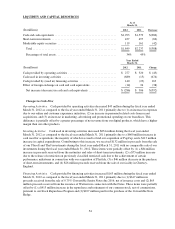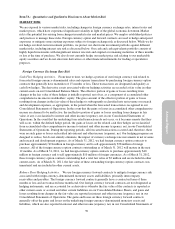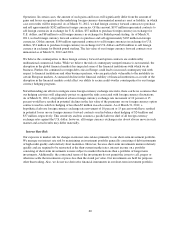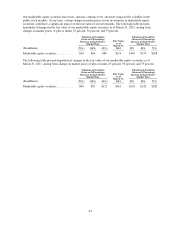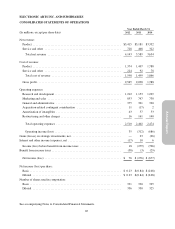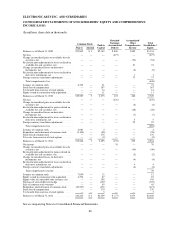Electronic Arts 2012 Annual Report Download - page 141
Download and view the complete annual report
Please find page 141 of the 2012 Electronic Arts annual report below. You can navigate through the pages in the report by either clicking on the pages listed below, or by using the keyword search tool below to find specific information within the annual report.
Annual Report
As of March 31, 2012, approximately $878 million of our cash, cash equivalents, and short-term investments and
$57 million of our marketable equity securities were domiciled in foreign tax jurisdictions. While we have no
plans to repatriate these funds to the United States in the short term, if we choose to do so, we would be required
to accrue and pay additional taxes on any portion of the repatriation where no United States income tax had been
previously provided.
In February 2011, we announced that our Board of Directors authorized a program to repurchase up to $600
million of our common stock over the next 18 months. We completed our program in April 2012. We
repurchased approximately 32 million shares in the open market since the commencement of the program,
including pursuant to pre-arranged stock trading plans. During the fiscal year 2012, we repurchased and retired
approximately 25 million shares of our common stock for approximately $471 million, net of commissions.
We have a “shelf” registration statement on Form S-3 on file with the SEC. This shelf registration statement,
which includes a base prospectus, allows us at any time to offer any combination of securities described in the
prospectus in one or more offerings. Unless otherwise specified in a prospectus supplement accompanying the
base prospectus, we would use the net proceeds from the sale of any securities offered pursuant to the shelf
registration statement for general corporate purposes, including for working capital, financing capital
expenditures, research and development, marketing and distribution efforts, and if opportunities arise, for
acquisitions or strategic alliances. Pending such uses, we may invest the net proceeds in interest-bearing
securities. In addition, we may conduct concurrent or other financings at any time.
Our ability to maintain sufficient liquidity could be affected by various risks and uncertainties including, but not
limited to, those related to customer demand and acceptance of our products, our ability to collect our accounts
receivable as they become due, successfully achieving our product release schedules and attaining our forecasted
sales objectives, the impact of acquisitions and other strategic transactions in which we may engage, the impact
of competition, economic conditions in the United States and abroad, the seasonal and cyclical nature of our
business and operating results, risks of product returns and the other risks described in the “Risk Factors” section,
included in Part I, Item 1A of this report.
Contractual Obligations and Commercial Commitments
Development, Celebrity, League and Content Licenses: Payments and Commitments
The products we produce in our studios are designed and created by our employee designers, artists, software
programmers and by non-employee software developers (“independent artists” or “third-party developers”). We
typically advance development funds to the independent artists and third-party developers during development of our
games, usually in installment payments made upon the completion of specified development milestones. Contractually,
these payments are generally considered advances against subsequent royalties on the sales of the products. These
terms are set forth in written agreements entered into with the independent artists and third-party developers.
In addition, we have certain celebrity, league and content license contracts that contain minimum guarantee
payments and marketing commitments that may not be dependent on any deliverables. Celebrities and
organizations with whom we have contracts include: FIFA, FIFPRO Foundation, FAPL (Football Association
Premier League Limited), and DFL Deutsche Fußball Liga GmbH (German Soccer League) (professional
soccer); National Basketball Association (professional basketball); PGA TOUR, Tiger Woods and Augusta
National (professional golf); National Hockey League and NHL Players’ Association (professional hockey);
National Football League Properties, PLAYERS Inc., and Red Bear Inc. (professional football); Collegiate
Licensing Company (collegiate football); ESPN (content in EA SPORTS games); Hasbro, Inc. (most of Hasbro’s
toy and game intellectual properties); and LucasArts and Lucas Licensing (Star Wars: The Old Republic). These
developer and content license commitments represent the sum of (1) the cash payments due under non-royalty-
bearing licenses and services agreements and (2) the minimum guaranteed payments and advances against
royalties due under royalty-bearing licenses and services agreements, the majority of which are conditional upon
performance by the counterparty. These minimum guarantee payments and any related marketing commitments
are included in the table below.
57




